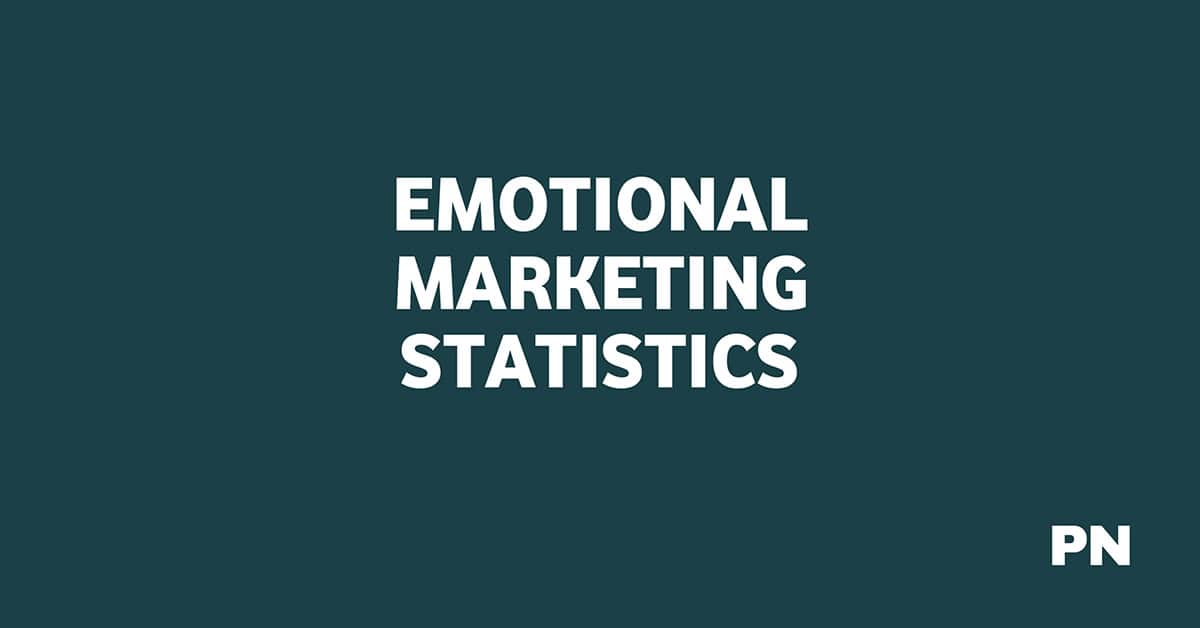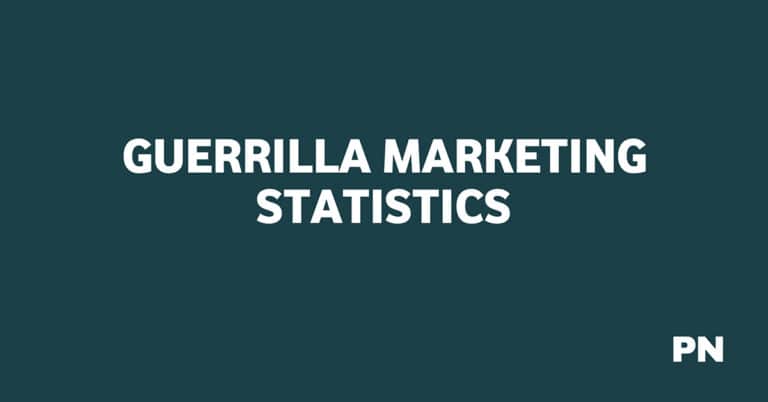25 Lovely Emotional Marketing Statistics

In the ever-evolving marketing world, connecting with consumers on a deeper, emotional level has become a game-changer for brands aiming to stand out in a crowded marketplace.
Emotional marketing, which focuses on eliciting specific feelings to influence consumer behavior, has proven to be a powerful strategy. But just how effective is it?
Consider this: a Nielsen study revealed that ads with emotional content performed almost twice as well (31% vs. 16%) compared to those with rational content alone.
Additionally, research by Harvard Business Review found that emotionally connected customers are more than twice as valuable as highly satisfied customers.
These statistics highlight the undeniable impact of emotional marketing on consumer engagement and brand loyalty.
In this article, I explore the fascinating world of emotional marketing statistics, exploring how tapping into emotions can drive significant growth and success for your brand.
1. The success rate of emotional marketing campaigns is 31%.
(Source: NeuroScience Marketing)
When you effectively tap into emotions, your brand is more likely to foster a deeper emotional relationship with consumers, which is crucial for long-term brand recognition and customer loyalty.
A key benefit of establishing an emotional bond is the increase in customer lifetime value. Customers who feel emotionally connected to your brand are more inclined to make repeat purchases and are prone to become brand advocates.
Brands that succeed in emotional engagement often enjoy a reciprocity of loyalty that extends beyond transactional loyalty programs.
2. Ad copy with pure emotional content performs twice as well (31% vs. 16%) compared to those with only rational content.
(Source: Nielsen)
Emotions drive decision-making processes more than cold facts do. Advertising that taps into feelings such as happiness, nostalgia, or even fear can resonate more deeply with viewers, making them more memorable and influential.
The stark contrast underscores the importance of developing content that strikes an emotional chord rather than just presenting rational arguments or facts.
But how do you leverage this?
- Understand your audience’s values and emotional triggers.
- Utilize storytelling to create a narrative that your audience can relate to emotionally.
- Apply visuals, music, and words to stir the desired emotion and create an impactful ad experience.
Remember, the aim is to make your ads feel relevant and personal to your viewers. Doing so significantly increases the likelihood of engaging your audience and inspiring action.
3. The rate of customers who recommend a brand based on emotional connection is 71%.
(Source: Motista)
Emotional marketing taps into your feelings, connecting you with a brand in a way that goes beyond just using their products or services. Statistics show a significant link between emotional connection and customer advocacy.
When you resonate emotionally with a brand, you are more likely to share your positive experience with others. This organic promotion is precious to businesses as personal recommendations often carry more weight than traditional advertising.
Your emotional connections are not random; they result from strategic marketing campaigns that tap into universal human feelings such as happiness, sadness, fear, or surprise.
Companies that understand and invest in emotional marketing are more likely to see a boost in customer recommendations.
4. There is a 38% chance that anger-inducing content will go viral.
(Source: Moz)
When crafting content for your marketing campaign, it’s essential to understand the substantial impact emotions have on virality.
Anger is a powerful emotion that can prompt immediate, compelled sharing. Content that triggers anger tends to receive higher engagement in likes, comments, and shares, increasing its reach.
Anger can be a call to action, inspiring users to spread the word, potentially resulting in movements or collective action.
Before leveraging anger in your marketing, ensure the content aligns with your brand’s image and values. Also, the possible consequences and the type of discussion it might spark should be considered.
Remember, while anger can accelerate the spread of your content, it’s vital to balance virality with your brand’s long-term reputation. Use this strategy judiciously to ensure it contributes positively to your marketing goals.
5. Ads with above-average emotional responses generate 23% of sales spikes.
(Source: Nielsen)
In marketing, leveraging emotions can significantly impact sales volume.
Emotional ads foster a deeper connection with your audience, increasing the likelihood that consumers will remember your brand.
Emotional responses come in various forms, ranging from happiness to surprise or even anger, each with a unique influence on consumer behavior. Your aim should be to craft messages that resonate emotionally with your target demographic.
6. Click-through rates for headlines with negative superlatives “worst” or “never” are 30% higher than those with positive superlatives “best” or “always”.
(Source: CXL)
Negative words grab attention by tapping into your audience’s fears and concerns, prompting them to seek more information.
People are naturally curious about avoiding adverse outcomes, so they are more likely to engage with content that could reveal essential warnings or mistakes.
Remember, using negative words without crossing the line into sensationalism is vital. Maintain credibility while using the natural draw of negatively connoted words to enhance engagement with your content.
7. Strong Emotional Videos are 2X More Likely to Be Shared Than Weak Emotional Videos.
(Source: Unruly)
Videos that evoke strong emotions can more effectively capture and maintain your attention. You are likelier to remember content that makes you feel powerful emotions.
When you strongly relate to a video, it reflects on your social identity, encouraging you to share it. Content eliciting strong feelings has a higher chance of spreading rapidly due to the compounding effect of social sharing.
To capitalize on this, focus your video content strategy on storytelling that strikes an emotional chord.
8. An emotional connection between a customer and the organization is 52% more valuable than a highly satisfied customer.
(Source: Harvard Business Review)
When you establish an emotional connection with your customers, you satisfy their immediate needs and embed your brand into their narrative.
Emotionally connected customers are more loyal. Unlike satisfied customers who might still consider competitors, those emotionally invested are less likely to stray.
Emotionally connected customers contribute substantially more to your revenue than satisfied customers. This enhanced value underlines the importance of tailoring marketing efforts to resonate emotionally.
9. A mere 15% of consumers say that brands can form emotional bonds with them.
(Source: Net Imperative)
In today’s market, your connection with brands often extends beyond the mere utility of products and services. An emotional bond can significantly enhance customer loyalty, yet only a few brands excel at creating it.
Interestingly, specific geographic regions, like Italy, have a higher rate of consumers—at 65%—reporting emotional engagement with brands.
This emphasizes the nuanced nature of emotional marketing and its varied impact across different cultures.
10. Regarding emotional engagement with brands, Italians are at the forefront at 65%.
(Source: Capgemini)
This statistic suggests that most Italian shoppers are not just buying products. Still, they also invest in brands that resonate with them personally and emotionally.
Your brand’s ability to evoke feelings and establish a meaningful relationship with your customers is incredibly potent in the Italian market.
The high percentage indicates a culture where brands are seen as an extension of one’s identity, emotional advertising is likely to be particularly effective, and customer loyalty is strongly driven by emotional attachment.
Your marketing strategy in Italy should lean toward creating an emotional narrative that aligns with customer values and lifestyle preferences.
11. 82% of consumers are loyal to their favorite brands when purchasing decisions, compared to only 38% with low emotional engagement.
(Source: Capgemini)
When you make a purchase, your decision is highly influenced by your connection to the brand. An emotional bond can double the brand loyalty rate compared to disengaged consumers.
Consistent quality, assurance of good customer service, and alignment of brand values with your personal beliefs often cultivate this emotional connection. Brands that prioritize privacy, offer a range of products, and support greater missions are likely to win your loyalty.
12. Subconscious factors influence 95% of purchases: Emotion-Driven Campaign Success Rates.
(Source: Inc.com)
Research in marketing psychology suggests that subconscious factors largely sway your purchasing decisions.
Engaging with advertisements or marketing content might make you feel your choices are primarily logical. However, your emotional responses are significant drivers behind the scenes.
Your subconscious mind responds to many variables that may seem arbitrary, yet they have a tangible impact on your purchase behavior. Recognizing this fact allows marketers to craft strategies that tap into your emotions, ultimately guiding your decision-making in their favor.
13. An Advertisement Emotionally Triggers 70% of Viewers Who Are Very Likely to Buy a Product.
(Source: Unruly)
When you interact with advertising, your emotional response plays a crucial role in the likelihood of making a purchase.
Your connection to an ad can be more persuasive than you think. The emotional draw not only spikes interest but also determines consumer decisions.
14. More than other sectors, 51% of financial services customers are emotionally engaged.
(Source: Capgemini)
Why is this percentage noteworthy? The financial services industry is in a unique position compared to other sectors.
Emotional engagement pertains to how customers feel about their financial service providers, ranging from a sense of security and trust to personal empowerment and prestige.
Your connection with your financial institution is not just transactional; it involves your well-being and future aspirations. Banks and investment firms that succeed in creating a strong emotional bond often enjoy higher levels of customer loyalty and advocacy.
15. The brain’s emotional area can process sensory information 20% faster than the cognitive area.
Your brain is a complex machine, and when it comes to processing sensory information, the emotional area, also known as the limbic system, has a fascinating advantage.
Storytelling is a critical tool used by marketers when you experience advertising. It’s designed to tap into your limbic system, potentially leading to quicker emotional connections.
These connections can influence your behavior and are crucial for industries focusing on customer experience, such as retail and financial services. Understanding this brain function can be valuable in the context of business growth and sales spikes.
Companies like Apple harness emotional marketing effectively. Their campaigns often resonate emotionally, resulting in a higher success rate of their marketing efforts.
16. 86% of Emotionally Engaged Consumers Expect Brands to Reciprocate Their Loyalty Beyond Loyalty Programs
(Source: Frog)
These consumers seek a mutual relationship where their devotion is recognized and rewarded in personalized and noteworthy ways.
17. Emotionally connected customers are likelier to spend double on their favorite brands.
(Source: Motista)
When you establish an emotional connection with a brand, your spending habits reflect this bond.
Customers who are emotionally engaged with a brand are more likely to recommend it to others and spend more on it, thus enhancing the value of word-of-mouth marketing.
Your strategy should, therefore, focus on building this connection. Doing so can encourage consumers to view your brand as more than just a supplier of goods or services but as a cherished part of their lives.
18. 58% of consumers between 18 and 21 are emotionally engaged.
(Source: Capgemini)
This statistic is important to consider if you aim to target your brand’s marketing strategies at a younger audience. Your success can be influenced by how well you understand and leverage the emotions that drive this demographic’s consumer behavior.
Your approach should be tailored to understand the general trends and appreciate the nuances of emotional engagement specific to this youthful demographic.
19. Four of five executives believe their brand understands consumers’ emotional needs and desires.
(Source: Capgemini)
This confidence level suggests a strong belief in the strategies employed to create meaningful connections with their audience.
However, you should know the gap between executive perception and consumer reality. While executives may be sure-footed about their understanding of consumer emotions, this self-assurance doesn’t always reflect consumer opinions.
20. 7 in 10 digital marketing professionals (71%) focus on creating emotional connections with consumers to build brand recognition.
(Source: Statista)
Emotional connections can be a powerful lever in your marketing strategy.
This is not just about presenting facts or features; it’s about resonating with your consumers’ feelings and experiences.
Your marketing tactics should nudge consumers not just to see but to feel. Incorporate narratives that inspire, engage with their sense of joy, create moments of surprise, or speak to common challenges. These are the pathways to forming a strong emotional brand connection.
21. Four out of five (81%) emotionally connected consumers promote brands to their closest circle and spend more on the brand, too.
(Source: Net Imperative)
Emotional connections between consumers and brands are more than fleeting sentiments—powerful drivers of brand loyalty and economic activity.
If you’re among the consumers who feel firmly attached to a brand, you will likely become an advocate within your network. This means actively promoting the brands you love to friends and family, essentially becoming a valuable extension of the brand’s marketing efforts.
This propensity to promote isn’t without financial implications. Your wallet reflects your heart when you’re emotionally connected to a brand.
Statistics show that not only do consumers like you become brand promoters, but you also tend to spend more on these brands. Your emotional investment translates into a higher monetary investment.
22. 82% of Top-Performing Companies Are Paying Closer Attention to the Human Experience Online.
(Source: PWC)
When you engage with a brand online, you might notice a trend among successful companies: they increasingly value your human experience on their digital platforms.
What does this mean?
Simply put, even as technological advancements like AI chatbots become more prevalent, these companies understand that they cannot replace the nuances of human contact.
The focus here is empathy, personalization, and emotional connection, which can greatly enhance user satisfaction and brand loyalty.
23. 69% of credit card swipes are from emotionally satisfied customers.
(Source: Lending Tree)
Understanding consumer behavior is paramount for marketers. Recent data demonstrates a compelling link between emotional satisfaction and spending habits.
This emotional connection translates to occasional purchases and consistent and frequent transactions. Brands that successfully foster emotional bonds can expect a tangible impact on their sales.
By centering your strategy on building an emotional rapport, you significantly increase the chances of turning satisfied customers into brand advocates and boosting your sales metrics. .
24. 76% of emotionally connected individuals desire multiple interaction channels, including online platforms.
(Source: Khris Digital)
This includes but is not limited to, online platforms such as social media, email, brand websites, and mobile apps.
Your audience embraces a multi-channel approach for a simple reason.
It’s about convenience, familiarity, and the seamless experience that aligns with their lifestyle. For instance, they might want to engage with your brand’s story or advertisement on social media and then quickly click through to purchase on your website.
25. 47% of surveyed respondents in the UK say TV is the media platform they found Emotional Ads on.
(Source: Statista)
In the United Kingdom, nearly half of the respondents in a recent survey indicated television as the primary medium where they encounter emotional advertising.
The data suggests that TV is vital in delivering emotional content that resonates with viewers.
With the rise of digital and social media marketing, television’s ability to elicit an emotional connection makes it a unique and powerful medium for advertisers.
Using Emotional Marketing to Grow Your Brand
Emotional marketing taps into your audience’s feelings, aspirations, and desires. It’s about connecting with them on a deeper level, creating a bond that goes beyond the transactional nature of traditional marketing.
Emotions drive decisions, and by leveraging this, you can build a loyal customer base and enhance brand recognition.
Strategies for Implementing Emotional Marketing
1. Know Your Audience’s Emotions
Conduct market research to understand your target audience’s emotional triggers. What are their pain points, dreams, and values? Use surveys, social media insights, and customer feedback to gather this information.
2. Craft Emotional Stories
Storytelling is a powerful tool in emotional marketing. Create narratives that resonate with your audience’s experiences. Share success stories, testimonials, or behind-the-scenes content that humanizes your brand and makes it relatable.
3. Use Visuals and Colors Wisely
Visual elements play a significant role in evoking emotions. Colors, images, and videos can trigger specific feelings. For instance, blue often conveys trust and calmness, while red can evoke excitement and urgency.
Use these elements strategically in your branding and marketing materials.
4. Appeal to Core Human Values
Align your brand with universal values such as family, love, freedom, or adventure. Campaigns emphasizing these values can create a strong emotional connection with your audience.
For example, a travel brand might focus on the joy of exploration and creating unforgettable memories.
5. Create Emotional Content
Produce content that evokes emotions such as joy, nostalgia, or empathy. This can be achieved through blog posts, social media updates, videos, and advertisements. Emotional content is more likely to be shared, increasing your brand’s reach and engagement.
6. Build a Community
Foster a sense of belonging among your customers by creating communities around your brand. Social media groups, forums, and loyalty programs can help in building emotional connections.
Engage with your community regularly, listen to their feedback, and show appreciation for their support.
7. Showcase Social Proof
Highlighting testimonials, user-generated content, and customer success stories can evoke emotions of trust and validation.
When potential customers see others benefiting from your products or services, they are more likely to feel confident about engaging with your brand.
8. Support Social Causes
Associating your brand with social causes can evoke positive emotions and strengthen customer loyalty. Consumers today are more socially conscious and prefer brands that contribute to social good.
Partner with non-profits, run campaigns for charitable causes or adopt sustainable practices to show commitment.
Measuring the Impact of Emotional Marketing
Track key metrics such as engagement rates, customer feedback, and brand sentiment to ensure your emotional marketing efforts are effective.
Use sentiment analysis and social listening tools to gauge your campaigns’ emotional response. Adjust your strategies based on these insights to continually improve and deepen your audience’s emotional connection.
Final Thoughts on Emotional Marketing Statistics
Emotional connections between brands and consumers are a marketing trend and an essential strategy in contemporary business practices.
The statistics speak for themselves, indicating a remarkable advantage for campaigns prioritizing emotional content.
As you integrate emotional marketing into your strategy, observe how consumer engagement and loyalty transform. Relationships built on emotional connections tend to be more resilient and long-lasting—crucial in a world where brand loyalty faces constant challenges.
Remember, the statistics indicate that tapping into emotions can result in more than just immediate transactions. It fosters a deeper bond with your audience, setting the stage for sustained business success in a competitive market.
Disclosure: We may earn commissions if you buy via links on our website. Commissions don’t affect our opinions or evaluations. We’re also an independent affiliate of many platforms, including ClickFunnels, Kartra, GoHighLevel, Podia, Northwest Registered Agent, and others. We’re not employees of these services. We receive referral payments from them, and the opinions expressed here are our own and are not official statements of these companies.





